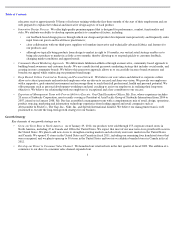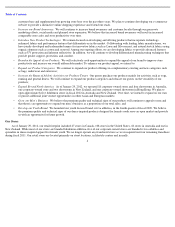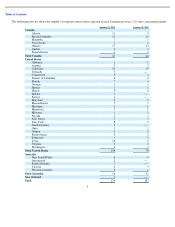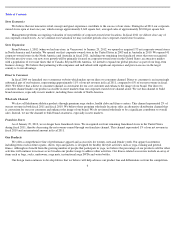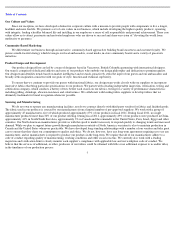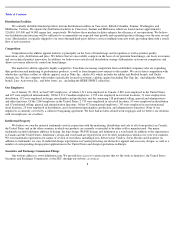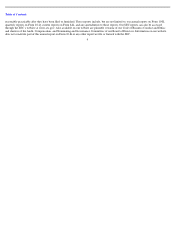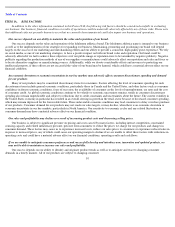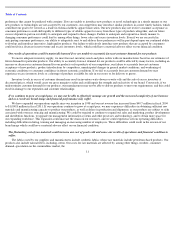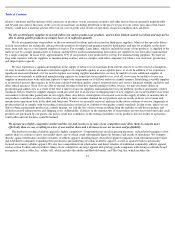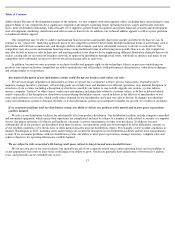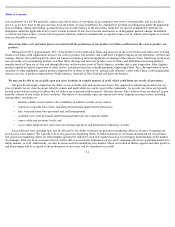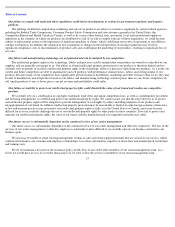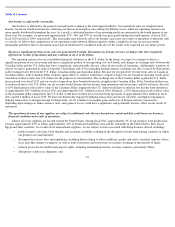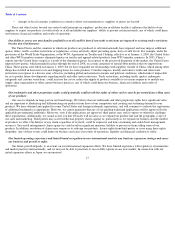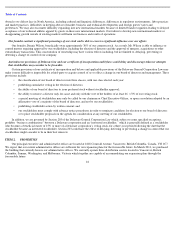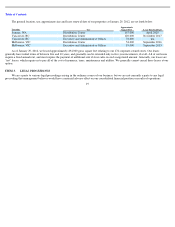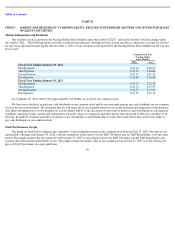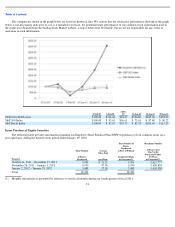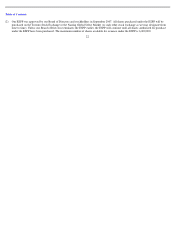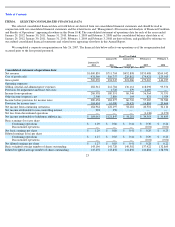Lululemon 2011 Annual Report Download - page 16
Download and view the complete annual report
Please find page 16 of the 2011 Lululemon annual report below. You can navigate through the pages in the report by either clicking on the pages listed below, or by using the keyword search tool below to find specific information within the annual report.
Table of Contents
Athleta brand. Because of the fragmented nature of the industry, we also compete with other apparel sellers, including those specializing in yoga
apparel. Many of our competitors have significant competitive advantages, including longer operating histories, larger and broader customer
bases, more established relationships with a broader set of suppliers, greater brand recognition and greater financial, research and development,
store development, marketing, distribution and other resources than we do. In addition, our technical athletic apparel is sold at a price premium
to traditional athletic apparel.
Our competitors may be able to achieve and maintain brand awareness and market share more quickly and effectively than we can. In
contrast to our “grassroots” marketing approach, many of our competitors promote their brands through traditional forms of advertising, such as
print media and television commercials, and through celebrity endorsements, and have substantial resources to devote to such efforts. Our
competitors may also create and maintain brand awareness using traditional forms of advertising more quickly than we can. Our competitors
may also be able to increase sales in their new and existing markets faster than we do by emphasizing different distribution channels than we do,
such as catalog sales or an extensive franchise network, as opposed to distribution through retail stores, wholesale or internet, and many of our
competitors have substantial resources to devote toward increasing sales in such ways.
In addition, because we own no patents or exclusive intellectual property rights in the technology, fabrics or processes underlying our
products, our current and future competitors are able to manufacture and sell products with performance characteristics, fabrication techniques
and styling similar to our products.
Any material disruption of our information systems could disrupt our business and reduce our sales.
We are increasingly dependent on information systems to operate our e-commerce website, process transactions, respond to guest
inquiries, manage inventory, purchase, sell and ship goods on a timely basis and maintain cost-efficient operations. Any material disruption or
slowdown of our systems, including a disruption or slowdown caused by our failure to successfully upgrade our systems, system failures,
viruses, computer “hackers” or other causes, could cause information, including data related to customer orders, to be lost or delayed which
could—especially if the disruption or slowdown occurred during the holiday season—result in delays in the delivery of merchandise to our
stores and customers or lost sales, which could reduce demand for our merchandise and cause our sales to decline. If changes in technology
cause our information systems to become obsolete, or if our information systems are inadequate to handle our growth, we could lose customers.
If we encounter problems with our distribution system, our ability to deliver our products to the market and to meet guest expectations
could be harmed.
We rely on our distribution facilities for substantially all of our product distribution. Our distribution facilities include computer controlled
and automated equipment, which means their operations are complicated and may be subject to a number of risks related to security or computer
viruses, the proper operation of software and hardware, electronic or power interruptions or other system failures. In addition, because
substantially all of our products are distributed from three locations, our operations could also be interrupted by labor difficulties, extreme or
severe weather conditions or by floods, fires or other natural disasters near our distribution centers. For example, severe weather conditions in
Sumner, Washington in 2011, including snow and freezing rain, resulted in disruption in our distribution facilities and the local transportation
system. If we encounter problems with our distribution system, our ability to meet guest expectations, manage inventory, complete sales and
achieve objectives for operating efficiencies could be harmed.
We are subject to risks associated with leasing retail space subject to long-term and non-cancelable leases.
We do not own any of our store facilities, but instead lease all of our corporate-owned stores under operating leases and our inability to
secure appropriate real estate or lease terms could impact our ability to grow. Our leases generally have initial terms of between five and ten
years, and generally can be extended only in five
-
13


